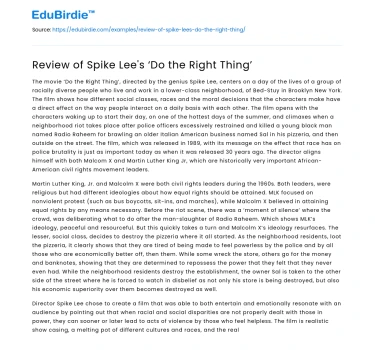Introduction
Spike Lee's "Do the Right Thing" (1989) is a seminal film that explores the complex dynamics of race relations and social justice in America. Set in the Bedford-Stuyvesant neighborhood of Brooklyn on the hottest day of the year, the film portrays a microcosm of societal tension that resonates beyond its immediate setting. Through its incisive narrative and vivid characters, Lee's film serves as both a cultural artifact and a timeless commentary on racial conflict. This essay aims to critically examine the thematic elements of the film, its impact on contemporary society, and its enduring relevance in the discourse on race and justice. By analyzing Lee's directorial choices and narrative strategies, we can better understand how "Do the Right Thing" challenges audiences to confront uncomfortable truths and consider their own roles in perpetuating or combating systemic inequality.
Exploration of Racial Tensions and Cinematic Techniques
At its core, "Do the Right Thing" is a film about racial tensions and the consequences of unchecked prejudice. Lee employs a variety of cinematic techniques to heighten the emotional resonance of these themes. For instance, the use of saturated colors and dynamic camera angles underscores the intensity of the environment and the volatility of the characters' interactions. The film's structure, which unfolds over a single day, amplifies the build-up of tension that culminates in a climactic confrontation. This choice of narrative pacing is instrumental in conveying the simmering frustration and hostility among the characters.
Save your time!
We can take care of your essay
- Proper editing and formatting
- Free revision, title page, and bibliography
- Flexible prices and money-back guarantee
Moreover, the film's dialogue is a powerful tool that Lee uses to articulate the various perspectives of his characters. Spike Lee himself has noted that the script was designed to reflect the authentic voices of the community (Lee, 1989). This authenticity is evident in the film's portrayal of Sal's Pizzeria as a focal point of cultural intersection. The pizzeria, owned by an Italian-American family, becomes a site of conflict as it symbolizes both community cohesion and cultural division. When Buggin' Out, a young African-American character, demands the inclusion of black figures on the pizzeria's "Wall of Fame," it sparks a debate that encapsulates the larger issues of representation and recognition in society.
Critics have lauded Lee's ability to present these complex issues without resorting to didacticism. Roger Ebert, a prominent film critic, described "Do the Right Thing" as "one of the most honest films about race relations ever made" (Ebert, 1989). However, some detractors argue that the film's ambiguous resolution fails to provide a clear moral stance. Yet, this ambiguity is precisely what makes the film so compelling. By refusing to offer easy answers, Lee challenges viewers to grapple with the discomfort and complexity of real-world racial dynamics.
Impact on Society and Counter-Arguments
Since its release, "Do the Right Thing" has had a profound impact on both popular culture and academic discourse. The film's depiction of racial conflict and police brutality has remained relevant, particularly in light of recent movements such as Black Lives Matter. Scholars have highlighted the film's prescience in anticipating contemporary debates over race and justice. For example, in her analysis of the film, cultural critic bell hooks emphasizes its role in "engaging viewers in a dialogue about racism and its effects" (hooks, 1990).
However, the film has not been without controversy. Some critics contend that its portrayal of violence, particularly the riot at the film's climax, could be perceived as justifying destructive behavior. In response to such criticisms, it is important to consider the film's broader context. Lee has asserted that the film is not an endorsement of violence but rather a reflection of the anger and frustration that arise from systemic oppression (Lee, 1989). By presenting violence as a consequence rather than a solution, the film invites viewers to examine the root causes of societal unrest.
Furthermore, the film's emphasis on individual agency and collective responsibility challenges audiences to reflect on their own roles in fostering change. Lee's decision to end the film with contrasting quotes from Martin Luther King Jr. and Malcolm X underscores the complexity of the issues at hand. While King's advocacy for nonviolence is juxtaposed with Malcolm X's acknowledgment of self-defense, the film suggests that both perspectives are necessary in the ongoing struggle for justice.
Conclusion
In conclusion, Spike Lee's "Do the Right Thing" remains a pivotal work in the cinematic exploration of race and social justice. Through its innovative use of narrative and visual techniques, the film presents a nuanced portrayal of racial tensions that continues to resonate with audiences today. By engaging with the film's themes and addressing counter-arguments, we gain a deeper understanding of its significance as both an artistic achievement and a sociopolitical commentary. Ultimately, "Do the Right Thing" challenges us to confront the pervasive realities of racism and consider our own responsibilities in the pursuit of equity and justice. As society continues to grapple with these issues, Lee's film serves as a powerful reminder of the enduring need for dialogue and action in the face of injustice.






 Stuck on your essay?
Stuck on your essay?

